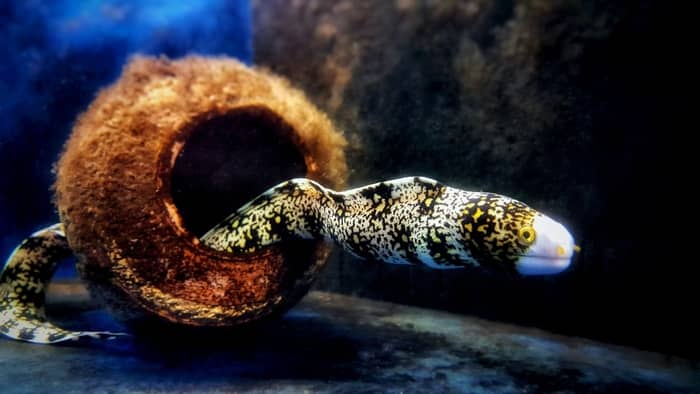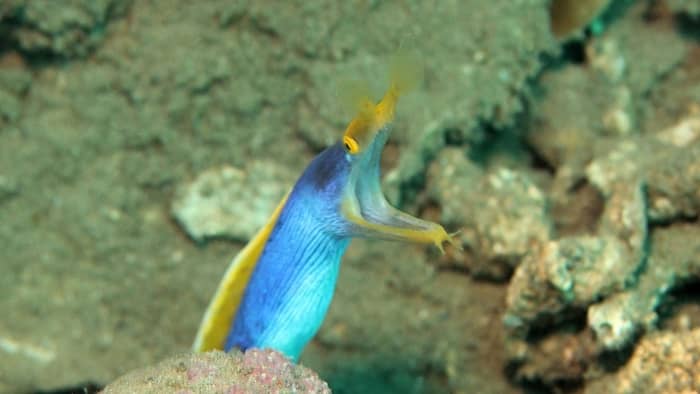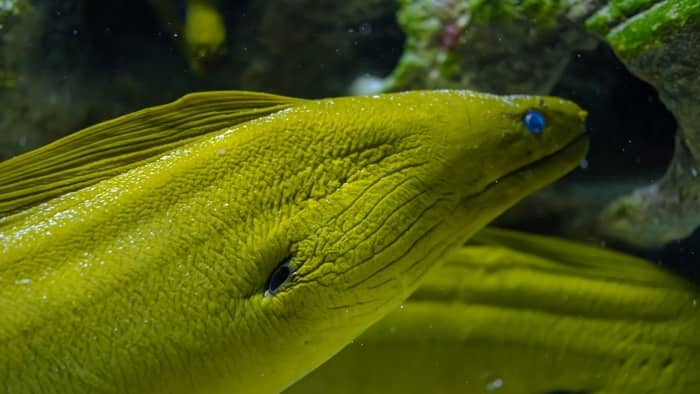Last Updated on November 9, 2021 by admins
Saltwater aquarium eels are unique creatures that capture everyone’s attention. They are most commonly found in tropical and temperate waters.
All eels belong to the Anguilliformes order. There are about 800 different species. Eels are divided into two main categories, freshwater, and saltwater.
Because saltwater aquarium eels live in similar conditions to “real eels”, the vast majority have simply developed a shape that is identical to that of “real eels”. In terms of their size, they can grow from a few inches to over 10 feet (304.8 cm) in length.
Some species such as Giant Moray (Gymnothorax javanicus) can grow up to 9 feet in length and weigh up to 66 pounds as an adult. Slender Moray Eel (Strophidon sathete), on the other hand, can grow up to an incredible 18 feet. However, you don’t have to worry, most aquarium species will not grow larger than 18 inches.
Because of their enchanting looks and grandeur, more and more people are choosing to buy saltwater aquarium eels. If you are one of them, this is everything you need to know!
Appearance (Form & Function)
The body of the saltwater eel is covered with a layer of mucus. Although not always the case, in some species this mucus is poisonous. The mucus is secreted by goblet cells. It acts as a protective barrier against abrasions from hiding out in the rocks.
It is important to remember that this mucus is very toxic to humans and that contact can result in human death.
When it comes to vision, eels rely on chemoreception. It’s a physiological response to chemical stimuli, to capture your food. Large nostrils, which can sniff the space around them, are also responsible for their success in hunting. Saltwater eels are nocturnal creatures. Thus, their lack of visual acuity does not interfere with normal functioning.
Saltwater eels are all predatory and have several adaptations for catching prey. They all have sharp, needle-like teeth so they can very easily dismember prey. So be careful, even a small aquarium eel can leave a nasty bite if you disturb it and put your hands in the aquarium in vain. However, they only attack in self-defense or if they are hand-fed.
Speaking of teeth/mouth, they have another set of pharyngeal jaws located in the throat. After biting the prey, the second set of jaws pulls that prey further into the eel’s throat. Some saltwater eels species even have “crushing teeth” to catch crabs, sea urchins, and mollusks.
What Colors Can Eels Be?
What makes sea eels special is certainly their variety of colors. They can be black, gray, brown, yellow, green, blue, orange, or white. However, that is not all, the colors can appear as stripes, spots, or even some other pattern.
Interestingly, they have the ability to camouflage, so prey or predators may not notice them until it’s too late.
What Do Saltwater Eels Eat?
As already mentioned, they’re carnivores, meaning they eat fish, mollusks (squid and cuttlefish), and crabs. In the wild, marine eels hunt in groups. This means that some species of fish are joining forces with eels in food hunting.
What Eats Saltwater Eels?
Although you might not think at first, saltwater eels do have few predators. Their predators are usually the apex predator in their ecosystem. Some of them are: grouper, barracuda, sharks, and let’s not forget – humans.
Caring For Saltwater Aquarium Eels
Firstly, as with all other animals, not all types of eels are recommended for a home saltwater aquarium. For example, some species can be dangerous to the inhabitants of your aquarium because they hunt and eat other fish. Also, pay attention to their size, as a larger eel will often try to swallow a smaller one.
Tank Size
Another thing to consider is the size, both of the water tank and the eel itself. Since some species grow up to several feet, be sure to choose a tank of the appropriate size.
The basic rule for choosing the perfect tank is:
- The minimum width of the tank must be wider than the length of the fish. So, that it doesn’t have to fold itself in half to turn around.
- The length of the tank must be several times the length of the fish. So, that it can swim a little before it hits the end.
Smaller species of saltwater eels will settle for the 75-gallon aquarium. On the other hand, larger specimens will require a 125-gallon tank or larger. The largest specimens are not suitable for home aquariums, they need tanks like those in public aquariums.
When it comes to filtration systems, you will need quality ones, because, eels produce large amounts of waste products.
Read more about: 200-Gallon Aquarium Dimensions
Décor
These animals adore hidden places. Therefore, make sure that there are at least two areas in the aquarium where they can hide their entire body. Eels without adequate hiding spots will be constantly stressed. That leads to the development of disease, loss of appetite, and behavioral changes
Covering The Aquarium
Did you know that some species of saltwater eel are excellent fugitives? Any opening in the lid of the aquarium big enough for an eel to poke its head through will be a great place to try to escape. Consider placing tight-fitting lids on your aquarium so the eel can’t push the lids up and escape.
Feeding
All saltwater eel species are carnivorous and consume either fish or crustaceans. However, you will not always be able to get live silversides and blue crabs. The good thing is that you can train them to accept fresh or frozen seafood instead.
Top Recommended Species
There are about 200 different species of moray eel but not all of them are recommended for the home aquarium.
Snowflake Eel
Common Names: Snowflake Moray Eel, Clouded Moray Eel
Scientific Name: Echidna nebulosa
Origin: Indo-Pacific
Length: 24 inches
Aquarium Size: 55 gallons
Ribbon Eel
Common Names: (Blue/Black/Yellow) Ribbon Eel
Scientific Name: Rhinomuraena quaesita
Origin: Indo-Pacific
Length: 3-4 feet
Aquarium Size: 55-75 gallons
Golden Dwarf Moray Eel
Common Names: Golden Dwarf Moray
Scientific Name: Gymnothorax melatremus
Origin: Indo-Pacific
Length: 12 inches
Aquarium Size: 55 gallons
In Conclusion
Before buying your first eel, make sure you have the correct tank size and a strong enough filter. In addition, be prepared for slightly higher food prices as opposed to a regular aquarium.
However, this unique and attention-getting group of fish will justify all the effort and money invested. If you have any questions or tips and tricks about these species of eels, write to us below!
Are you planning to buy an aquarium? You may find these articles helpful.
Learn more about: Aquarium Sump Pump Size Calculator



Leave a Reply
You must be logged in to post a comment.